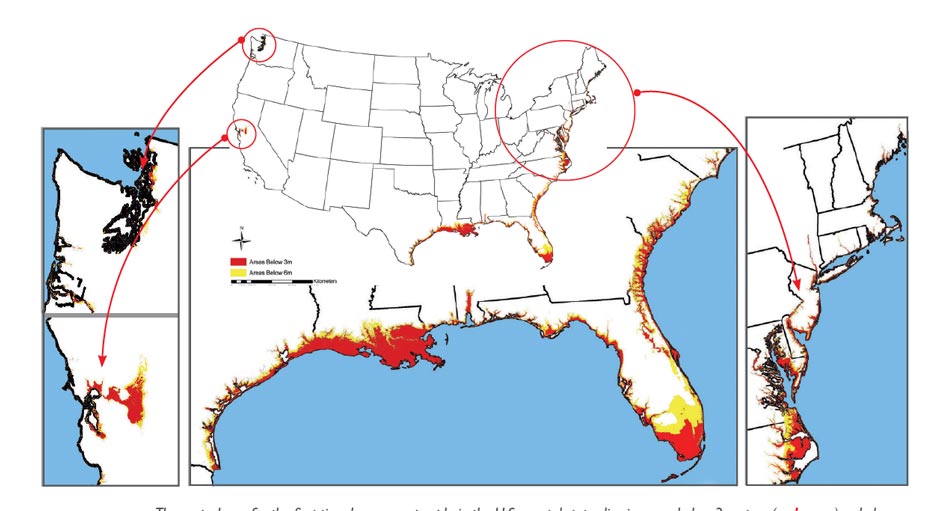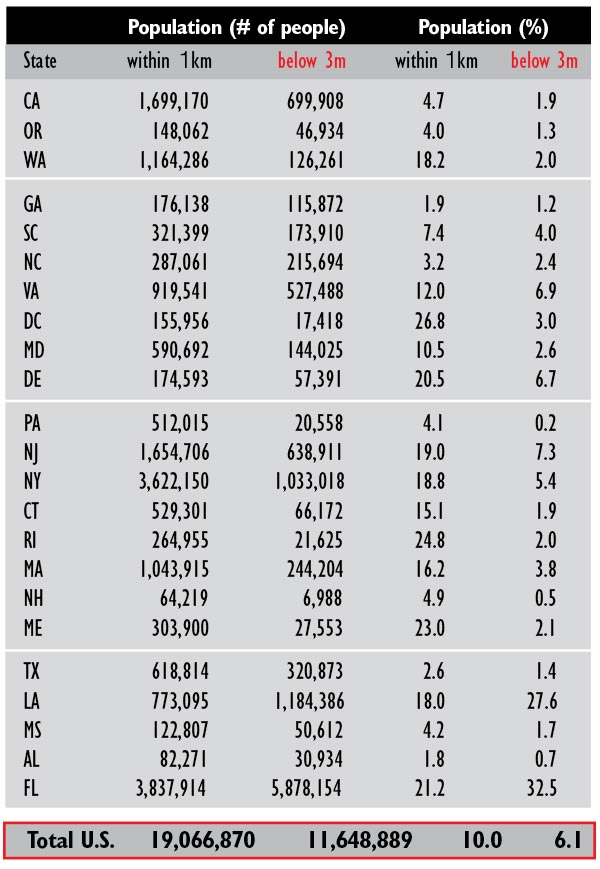How many people live in vulnerable coastal areas of the U.S.A.?
Heads above water
How many people live in vulnerable coastal areas of the U.S.A.?

The map shows for the first time how many people in the U.S. coastal states live in areas below 3 meters (red areas) or below 6 meters (yellow areas) above sea level. The resulting table on the next page specifies for each state the population that lives in the 3 meter range (red figures) or, alternatively, that lives within 1 km from the coast. The state’s names are abbreviated. Combined values for all 23 coastal states of the U.S. are given in the box at the bottom.
This detailed information can now be used to develop better impact
mitigation and prevention strategies in coastal zone planning and disaster management. Focusing on states with a large absolute share of vulnerable people such as Florida, Louisiana and New York would provide protection for the largest number of people. And states which have a small total population, but of which a large relative share of people is vulnerable, such as the District of Columbia, Rhode Island, Maine, and Delaware, may want to emphasize coastal disaster prevention over other civil defense activities.
The same methodology can be applied worldwide to estimate the coastal populations most vulnerable to global climate change. The Louisiana State University group is currently adapting this methodology for application in the Caribbean.
Science Snapshots 3 -The Story
In any given coastal area, how many people live within one kilometer of the coast? Or in areas that are less than three meters above sea level? This is a critical question if one wants to estimate the impacts of climate change on coastal regions vulnerable to sea-level rise or to more and stronger storms. Surprisingly, reliable answers to this question were not available for the U.S. and many other parts of the world.
Florida has the largest number of people living in areas below 3 meters (5.9 million people; 32.5%), followed by Louisiana (1.2 million people; 27.6%) and New York (1.0 million people; 5.4%). Some states have over 20 percent of their population living within 1 km from the coast, e.g. Rhode Island, Maine, Florida, and Delaware, and the District of Columbia.These are potentially most affected by storm surges or sea-level rise.
Ocean levels very likely will rise as a consequence of global warming. The more conservative IPCC estimates from 2007 predict an 18-59 cm rise of sea levels until 2100 (see IPCC report, 2007, and the study by Rahmstorf, 2007, in Science). Cyclone activities are at a long-time high (see Science Snapshot 2) which will result in storm surges that reach higher elevations along the coasts; seawater will be spreading further inland. Coastal communities are therefore very vulnerable to the combination of sea level rise and enhanced cyclone activities.

In a recent paper, Nina Lam and her research group at the Department of Environmental Sciences at Louisiana State University, which is part of one of the IAI’s research networks, used state-of-the-art geographic information system (GIS) methodology to develop fine-scale estimates of the vulnerable population along the U.S. coast. They utilized published datasets such as national census data (from 2006) and shoreline information for the 23 coastal states in the conterminous United States.
Research results show that approximately 19 million people reside within a range of one kilometer from the shoreline in the conterminous U.S., 10.0 % of the combined population of the 23 coastal states, or 6.4% of the whole U.S. population. About 11.6 million people live below the three-meter elevation (6.1 % of coastal population), and roughly 6.3 million people fulfill both criteria (living below 3 m and within 1 km from the coast: 3.3% of coastal population).
Further reading
Lam, N.S.N., Arenas, H., Li, Z., and Liu, K.B. 2009.
An estimate of population impacted by climate change along the U.S. coast. Journal of Coastal Research, Special Issue 56: 1522-1526.
Rahmstorf. S. (2007): A Semi-Empirical Approach to Projecting Future Sea-Level Rise. Science 315: 368-370.
IPCC (2007): Climate Change 2007: Synthesis Report. Summary for Policymakers.
Global Change Science Snapshots are intended to inform IAI clients and the interested public about important results of international research carried out under IAI auspices.
Design: Shadi Ardalan
Editorial Board: Christopher Martius, Ione Anderson, Paula Richter, Holm Tiessen
Cite as: IAI (2010): Heads above water. How many people live in vulnerable coastal areas of the U.S.A.? Science Snapshots 3. IAI.
Research funded under CRN 2050 by IAI, NSF.
Download PDF
Download PDF in Spanish
